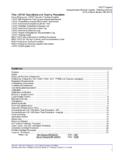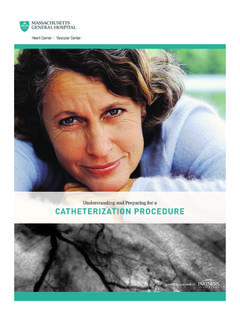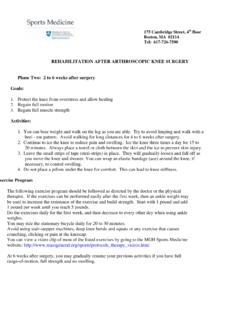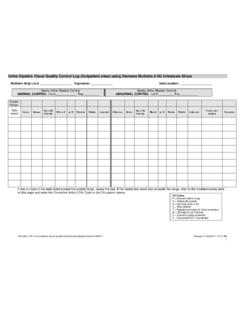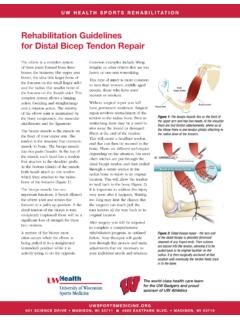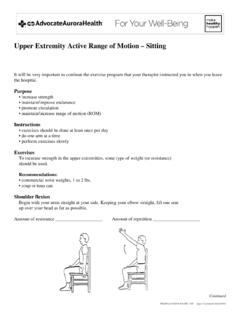Transcription of Rehabilitation Protocol for Distal Biceps Tendon Repair
1 Rehabilitation Protocol for Distal Biceps Tendon Repair This Protocol is intended to guide clinicians through the post-operative course for Distal Biceps Tendon Repair . This Protocol is time based (dependent on tissue healing) as well as criterion based. Specific intervention should be based on the needs of the individual and should consider exam findings and clinical decision making. The timeframes for expected outcomes contained within this guideline may vary based on surgeon s preference, additional procedures performed, and/or complications. If a clinician requires assistance in the progression of a post-operative patient, they should consult with the referring surgeon. The interventions included within this Protocol are not intended to be an inclusive list of exercises.
2 Therapeutic interventions should be included and modified based on the progress of the patient and under the discretion of the clinician. Considerations for the Post-operative Distal Biceps Tendon Repair Many different factors influence the post-operative Distal Biceps Tendon Repair Rehabilitation outcomes, including post-operative pain and edema as well as specific suture material chose by surgeon. It is recommended that clinicians collaborate closely with the referring physician regarding type of Repair and precautions with range of motion and lifting restrictions. If you develop a fever, unresolving numbness/tingling, excessive drainage from the incision, uncontrolled pain or any other symptoms you have concerns with, please contact referring physician.
3 P HA SE I: IMMED IA TE P OST-OP (D ay 0-1 WEEK A F TER SURG ERY ) Rehabilitation Goals Reduce post-operative pain Reduce post-operative edema Protect surgical Repair Patient education of surgical precautions and expectations of progression Optimize tissue healing environment Precautions Non-weight bearing on repaired upper extremity. AVOID active elbow flexion and forearm supination until Week 4 NO LIFTING with repaired upper extremity until Week 8 Brace Initial immobilization: posterior elbow orthosis with elbow in 90 degrees flexion with forearm in 0 degrees of pronation/ supination for 5-7 days (unless otherwise indicated by surgeon) Hinged elbow brace: with brace set locked from 90 degrees of flexion to full flexion, initiate elbow flexion and forearm pronation/ supination passive range of motion (PROM) at 5-7 days post-operative Interventions Modalities to reduce post-operative edema and pain control Grip strengthening with forearm/wrist in neutral position Scar massage Criteria to Progress Adequate maintenance of post-operative pain and edema control Progression of elbow passive range of PROM in elbow flexion and forearm pronation/ supination within confines of hinged elbow orthosis is based upon referring surgeon s assessment of surgical Repair .
4 Mas s a ch u s etts G en era l Br ig h am S p o rts Me d icin e 2 P HA SE II: IN TERMED IA TE P OST-OP (2-6 WEEKS A F TER SURG ERY ) Rehabilitation Goals Reduce post-operative pain Reduce post-operative edema Protect surgical Repair Patient education of surgical precautions and expectations of progression Optimize tissue healing environment (avoid nicotine and caffeine) Improve elbow flexion and forearm pronation/ supination PRROM in hinged brace Initiate elbow flexion and forearm pronation/ supination active-assisted range of motion (AAROM) and active range of motion (AROM) in hinged brace Precautions Non-weight bearing on repaired upper extremity No lifting with repaired upper extremity Brace Hinged Elbow Brace (set locked to allow restricted extension ROM): 2nd week.
5 90 degrees to full flexion 3rd week: 45 degrees to full flexion 4th week: 30 degrees to full flexion 5th week: 20 degrees to full flexion 6th week: discharge hinged elbow brace Additional Interventions *Continue with Phase I interventions as indicated Swelling Management Ice, compression, elevation (check with MD re: cold therapy) Retrograde massage Range of Motion Week 2 Elbow flexion/extension PROM within confines of hinged elbow brace Forearm pronation/ supination PROM with elbow at 90 degrees, in hinged elbow brace Shoulder AROM as needed, avoiding hyper-extension Wrist and hand AROM Week 3 Elbow flexion/extension PROM within confines of hinged brace Forearm pronation/ supination PROM with elbow at 90 degrees flexion in hinged elbow brace Week 4 Elbow flexion/extension AROM in gravity-eliminated plane in hinged elbow brace Forearm pronation/ supination AROM with elbow at 90 degrees flexion and forearm supported Week 5 Elbow flexion AROM in gravity-eliminated plane in hinged elbow brace, progressing to against gravity in hinged elbow brace.
6 With removal of brace for AROM if full and painless against gravity Forearm pronation/ supination AROM with elbow at 90 degrees flexion without support Criteria to Progress Adequate maintenance of post-operative pain and edema control Full elbow flexion AROM and forearm pronation/ supination AROM against gravity, without brace, and without increased pain or swelling P HA SE III: L ATE P OST-OP (7-10 WEEKS A FTER SURG ERY ) Rehabilitation Goals Protect surgical Repair Prevent muscle inhibition Improve cardiovascular endurance Maintain scapulothoracic endurance Precautions Non-weight bearing to repaired upper extremity until Week 8 Mas s a ch u s etts G en era l Br ig h am S p o rts Me d icin e 3 Begin gradual weight bearing with elbow flexed at Week 8, progress to extended elbow by Week 10 No lifting with repaired upper extremity until Week 8 Additional Interventions *Continue with Phase I-II Interventions as indicated Range of Motion: Begin combined/composite motions ( extension with pronation).
7 If significant ROM deficits present at week 8, discuss progression to more aggressive PROM with referring orthopedic surgeon Weight-Bearing Progression: Wall push ups Push ups on elevated table Modified forearm plank (elbows bent) Quadruped progression with elbows extended: Scapulothoracic Strength/Endurance: Prone scapular slides with shoulder extension to neutral Serratus wall slides Seated scapular retraction Wall scapular protraction/retraction with elbows extended at Week 10 Conditioning: Treadmill walking and running Stationary bike (gradually progress weight bearing on involved upper extremity over Weeks 7-10 beginning with elbow flexed and progressing to elbow extended Criteria to Progress Full, pain-free ROM of shoulder, elbow, wrist, and hand Proper scapulothoracic mechanics Full A/PROM to repaired elbow and forearm with normal grip strength P HA SE IV : TRA N SITION A L (11-15 W EEKS AF TER SURG ERY ) Rehabilitation Goals Increase functional strength of operated upper extremity Initiate strengthening at Week 10 Additional Interventions *Continue with Phase II-III interventions Range of Motion.)
8 Continue with combined/composite range of motion, focusing on proper mechanics of shoulder, elbow, wrist, and hand Strengthening: At Week 10, initiate submaximal isometrics of elbow flexors, extensors, supinators, and pronators at Week 10. Over Weeks 10-12, progress from submaximal isometrics to submaximal isotonics: o Resisted bicep curl (pronated, neutral, and supinated grip) o Resisted pronation and supination o Resisted tricep extension Progress shoulder strengthening program with light upper extremity weight training: o Standing resisted shoulder elevation o Standing shoulder PNF diagonals o Resisted Prone I, Prone Y, Prone T o Rows o Resisted shoulder ER, Resisted shoulder IR o Supine shoulder protraction o Wall push ups o Quadruped stability progression Criteria to Progress Full, pain-free ROM of shoulder, elbow, wrist, and hand Proper scapulothoracic mechanics Mas s a ch u s etts G en era l Br ig h am S p o rts Me d icin e 4 P HA SE V.
9 EA RL Y RETURN TO SP ORT (4-6 MON THS A F TER SURG ERY ) Rehabilitation Goals Increase strength and endurance of repaired upper extremity Additional Interventions *Continue with Phase II-IV interventions as indicated Advanced Strengthening: Continue Phase IV exercises Rhythmic stabilizations High plank stability progression Bilateral upper extremity plyometrics after Week 16 (based on control and response) Single arm plyometrics after Week 20-22 (based on control and response) Criteria to Progress Full, pain-free A/ROM of shoulder, elbow, wrist, and hand Proper scapulothoracic mechanics Pain-free performance of HEP P HA SE V I: UN RESTRIC TED RETURN TO SP ORT (6+ MON THS A F TER SURG ERY ) Rehabilitation Goals Increase strength of operated upper extremity Return to sport Additional Interventions *Continue with Phase II-V interventions as indicated Focus on progression of sport-specific movements Graded participation in practice, with full, pain-free practice prior to participation in competition Criteria to Discharge Full, painless elbow/wrist ROM Shoulder total ROM within 5 of non-throwing shoulder > 40 horizontal adduction of throwing shoulder < 15 Glenohumeral IR deficit.
10 Elbow, shoulder and wrist strength with MMT, HHD or isokinetic: o ER/IR ratio: 72-76% o ER/ABD ratio: 68-73% o Throwing shoulder IR: > 115% of non-throwing shoulder o Throwing shoulder ER: > 95% of non-throwing shoulder o Elbow flexion/extension: 100-115% of non-throwing shoulder o Wrist flexion/extension: 100-115% of non-throwing shoulder Functional test Scores: o Prone Drop ball test 110% of non-throwing side o 1-arm balls against wall @ 90/90: 2lb ball 30 seconds with no pain 115% of throwing side o Single arm step down test: 8-inch 30 seconds Satisfactory score on Kerlan-Jobe Orthopedic Clinic shoulder and elbow score (KJOC) throwers assessment Physician Clearance Independent with HEP Return-to-Sport For the recreational or competitive athlete, return-to-sport decision making should be individualized and based upon factors including but not limited to previous injury history, the level of demand on the upper extremity, contact vs non-contact, and frequency of participation.


